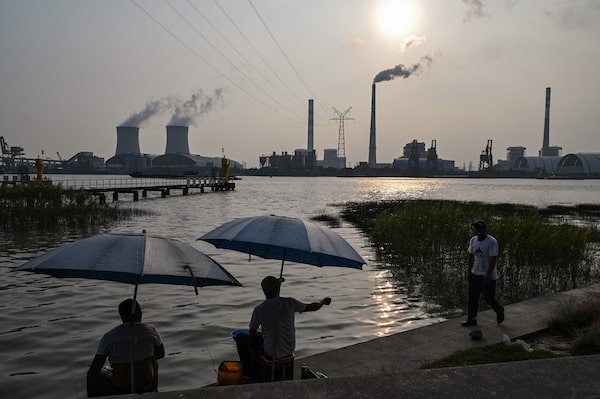
Anglers fish along the Huangpu river across the Wujing Coal-Electricity Power Station in Shanghai on Sept. 28, 2021.HECTOR RETAMAL/AFP/Getty Images
China has released a road map for how the country plans to reach peak carbon emissions by 2030 and achieve full carbon neutrality by 2060, ahead of a key UN climate summit next month. But Beijing has not announced any major new climate pledges despite calls from UN Secretary-General Antonio Guterres and others for an ambitious plan in the run-up to COP26 in Glasgow.
China is the world’s largest emitter of greenhouse gasses (though the United States far outstrips it when it comes to emissions per capita), and so Beijing’s participation is vital to hitting the Paris Agreement’s goals of limiting warming to less than 2 C by the end of the century, already a long shot.
The new guiding document released Monday, while full of superlatives about China’s plans and the country’s “unswerving commitment to honouring its words by concrete actions,” falls short of the bar set by Mr. Guterres.
Lauri Myllyvirta, lead analyst at the Centre for Research on Energy and Clean Air, a European think tank, said that “rather than a target-setting document that would prescribe emissions goals for different sectors, the document describes a massive regulatory and policy-making effort.”
“This could be a disappointment for people who were expecting more ambitious targets, but it’s also a good thing, as the sum total of these policies could well deliver an earlier peak,” he wrote on Twitter.
Nonfossil fuels currently amount for about 15 per cent of total energy consumption in China, according to government data. By 2030, this is due to increase to around 25 per cent, reaching 80 per cent by 2060.
On Tuesday, China published a carbon peak action plan, laying out key tasks for industry and the wider public to hit the 2030 goal. The plan includes targets of 1,200 gigawatts wind and solar capacity by the end of the decade and further investment in nuclear and hydro power. However, as Mr. Myllyvirta noted, there were “pretty much no new numerical targets” contained within it.
Climate researchers and activists had been hoping for China to bring its 2030 peak deadline forward to 2025 or even earlier. The lack of updated (and more stringent) targets is important, as according to the Climate Action Tracker, which pegs countries’ commitments to what is needed to hit Paris targets, China’s pre-existing plans are insufficient if it is to “match its long-term net-zero goal.”
“If all countries were to follow China’s approach, warming would reach over 2 C and up to 3 C,” it said in a recent report.
For now, China remains hugely dependent on coal, something that was underlined by power shortages in recent weeks, which hit manufacturing and residential electricity across large swaths of the country. Moves to shore up supply ahead of winter – including bringing in controls on pricing and allowing mines to increase production – sparked concern among some observers that Beijing may have balked at the first major test of its climate ambitions.
In a commentary published Monday, state news agency Xinhua said “China does not need to sacrifice economic growth when implementing climate action policies.”
But while the country is investing billions in renewable energy and electric vehicles, its emissions targets remain underwhelming, according to a new report from Australia’s Lowy Institute published this week.
“There is no credible emissions pathway toward the 1.5 C goal without significant movements from China in particular to accelerate its energy transition and decarbonization over the next decade,” author Sam Geall wrote. “While the country is known to ‘under-promise and over-deliver,’ the lack of ambition in the near term is a response to domestic threats of social instability and economic stagnation, and a more challenging global macro and geopolitical environment. These pose major challenges for China’s energy transition.”
China’s new emissions plan, along with President Xi Jinping’s expected absence from COP26, may have dampened hopes for the summit, but the country is not the worst offender in this regard. The BBC revealed this month that Saudi Arabia, Japan and Australia, among other countries, have been lobbying the UN to play down the need to move rapidly away from fossil fuels.
Beijing may be willing to agree to bring up its goals, or even announce new ones, it just isn’t prepared to do so unilaterally before negotiations begin.
There remains some cause for optimism, said Li Shuo, a senior climate officer with Greenpeace East Asia, particularly if you read the tea leaves of recent climate negotiations between Beijing and Washington, which took place this year despite the two superpowers’ frosty relations otherwise.
In a joint statement released in April, the United States and China said they were “firmly committed to working together and with other parties to strengthen implementation of the Paris Agreement.”
Mr. Li noted the absence of “common but differentiated responsibilities” from the statement as evidence that Beijing had shifted its stance somewhat behind the scenes. CBDR refers to the principle that more developed countries should bear greater costs in tackling climate change, and China has typically presented itself as part of the poorer club, despite being the world’s second-largest economy.
“If you let China write the statement, [CBDR] would certainly be there,” Mr. Li said. “So that is pretty significant diplomatic progress.”
This was, he added, proof that “engagement still matters. It can actually make an impact.
“The key question for the next few weeks is whether this is the limit, have we already exhausted the potential for diplomacy?”
Our Morning Update and Evening Update newsletters are written by Globe editors, giving you a concise summary of the day’s most important headlines. Sign up today.
 James Griffiths
James Griffiths